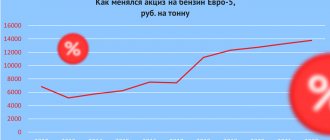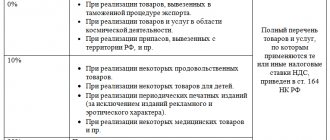What counts as implementation?
Goods are considered sold if the ownership of them has passed from the seller to the buyer (Clause 1, Article 39 of the Tax Code of the Russian Federation).
For the purposes of calculating excise taxes, the following operations are considered to be sales:
- gratuitous transfer of ownership of excisable goods or the use of excisable goods with payment in kind (subclause 1, clause 1, article 182 of the Tax Code of the Russian Federation);
- shortage of excisable goods in excess of the norms of natural loss (clause 4 of article 195 of the Tax Code of the Russian Federation).
When to charge excise tax
When selling (transferring) excisable goods, accrue excise tax on the day of shipment (transfer) to the buyer (recipient) of the goods (clause 2 of Article 195 of the Tax Code of the Russian Federation, letter of the Ministry of Finance of Russia dated January 14, 2010 No. 03-07-06/03).
If an organization sells goods at retail, then the date of sale for the purposes of calculating excise taxes is the date of transfer of goods to the division that carries out retail sales (clause 2 of Article 195 of the Tax Code of the Russian Federation).
An exception is the case of the sale of goods pledged if they have been in the possession of the pledgee since the conclusion of the pledge agreement. In this case, excise tax can be charged only after a public auction. This is explained by the fact that when concluding a pledge agreement, goods are transferred to the pledgee not for the purpose of sale (Article 337 of the Civil Code of the Russian Federation).
If the obligation to pay excise duty is related to the discovery of a shortage of goods, the date of sale is the date the shortage was discovered. At the same time, excise tax is imposed on the quantity of missing goods that exceeds the norms of natural loss (clause 4 of Article 195 of the Tax Code of the Russian Federation).
For transactions of transfer of goods produced from customer-supplied raw materials, excise duty is charged on the date of signing the acceptance certificate for such goods (Clause 2 of Article 195 of the Tax Code of the Russian Federation).
Accrue excise tax on all transactions, the date of implementation (transfer) of which relates to the current month (clause 5 of Article 194, Article 192 of the Tax Code of the Russian Federation).
Situation: at what point should excise tax be charged when selling goods through an intermediary?
When selling goods under intermediary agreements, accrue excise tax at the time of transfer of goods to the intermediary.
It is explained this way.
When selling manufactured excisable goods, an object of excise taxation arises (subclause 1, clause 1, article 182 of the Tax Code of the Russian Federation).
The sale of goods is recognized as the transfer of ownership of goods (on a compensated or gratuitous basis) from one person to another (clause 1 of Article 39 of the Tax Code of the Russian Federation). That is, in general, the date of sale is considered to be the date of transfer of ownership.
At the same time, for the purposes of calculating excise taxes, the date of sale of excisable goods is defined as the day of their shipment (transfer) (clause 2 of Article 195 of the Tax Code of the Russian Federation).
Thus, if the terms of the agreement provide for the transfer of ownership, excise duty must be charged on the date of shipment of goods as part of the execution of such an agreement, regardless of the date of transfer of ownership or the date of payment. This conclusion is confirmed by the letter of the Ministry of Finance of Russia dated January 14, 2010 No. 03-07-06/03.
When selling goods through intermediaries, ownership of the goods remains with the manufacturer until they are sold by the intermediary (Clause 1, Article 996, Article 1011 of the Civil Code of the Russian Federation). However, they are transferred to an intermediary for the purpose of their sale, as a result of which ownership from the manufacturer will pass directly to the buyer. Therefore, based on the rules set out above, excise duty must be charged on the date of shipment of goods to the intermediary. Similar explanations are contained in the letter of the Ministry of Finance of Russia dated October 7, 2008 No. 03-07-06/87.
Excise tax rates
After determining the moment of accrual of excise duty, determine the excise tax rate on the sold (transferred) product. This is due to the fact that the procedure for determining the tax base depends on the type of tax rates established for various excisable goods.
Tax legislation provides for three types of excise tax rates:
- hard or specific - in rubles per unit of measurement of the volume of excisable goods sold (transferred);
- ad valorem - as a percentage of the price (cost) of sold (transferred) excisable goods;
- combined - simultaneously including both fixed and ad valorem tax rates.
Currently, only two types of tax rates apply:
- combined – established for cigarettes and cigarettes;
- solid or specific - established for other excisable goods.
This conclusion follows from the provisions of paragraph 2 of Article 187 and Article 193 of the Tax Code of the Russian Federation.
The excise tax rate is determined based on the provisions of Article 193 of the Tax Code of the Russian Federation.
Situation: at what rate should the excise tax be charged on the sale of carbonated wine products with a volume fraction of ethyl alcohol over 8.5 percent?
When selling carbonated wine products, charge excise tax at the rate established for sparkling (champagne) wines.
This is explained as follows.
According to the All-Russian Classification of Products (OKP), wine products with a volume fraction of ethyl alcohol over 8.5 percent are carbonated wine (OKP code 15.93.11.210). That is, wine with a volume fraction of ethyl alcohol from 8.5 to 12.5 percent, obtained by artificially saturating table wine material with carbon dioxide. In turn, carbonated wines (code 15.93.11.210) are included in group 15.93.11 “Sparkling and carbonated wines.” Even if carbonated wine products are made on the basis of fruit wines, they cannot be classified as fermented drinks (code 15.94.10).
For alcoholic products, the excise tax rates established in Article 193 of the Tax Code of the Russian Federation are applied. There is no separate excise tax rate for carbonated wines. However, based on the grouping of alcoholic beverages presented in the All-Russian Classification of Products, for the purpose of calculating excise taxes, carbonated wines should be classified as sparkling wines (champagne).
Thus, when selling carbonated wine products with a volume fraction of ethyl alcohol over 8.5 percent, apply an excise tax rate of 26 rubles. for 1 l.
How to calculate excise tax on tobacco and cigarettes: calculations, examples
The amount of excise duty established in hard form is calculated using the formula:
Excise fixed rate = KolAktsPr * Ratefixed,
where KolAktsPr is the quantity of excisable goods (in kilograms, pieces, milliliters); Fixed rate - the excise duty rate established in hard form (rubles) in relation to a unit (kilogram, milliliter) of product.
Let's look at an example. Based on the acceptance certificate dated 09/03/2022, TabakProm JSC transfers the following products to the retail outlet:
- tobacco for hookahs – 3.5 kg;
- electronic cigarettes – 200 pcs.;
- liquid for electronic cigarettes – 1.5 l (1500 ml).
Let's calculate the amount of excise duty payable on tobacco and tobacco products:
- We calculate the excise tax on tobacco for hookahs at a rate of 5,280 rubles/1 kg: 3.5 kg * 5,280 rubles. = 18.480 rub.
- When calculating the excise tax on electronic cigarettes, we use a rate of 44 rubles/1 piece: 200 pieces. * 44 rub. = 8,800 rub.
- The excise tax on liquid for electronic cigarettes is calculated at a rate of 11 rubles/1 ml:
1500 ml * 11 rub. = 16,500 rub.
The total amount of excise tax payable on tobacco products transferred for sale is 44,140 rubles. (18,840 rubles + 8,800 rubles + 16,500 rubles).
When calculating the excise tax on cigarettes and cigarettes, a combined rate is used , which includes a fixed and interest rate:
- A flat rate is understood as a fixed fee amount for 1000 units of tobacco products in rubles.
- The interest rate is determined based on the maximum retail price. To calculate the maximum price, the established value of the minimum retail cent is used (the minimum price is equal to 75% of the maximum price). Thus, from July 1, 2022, the maximum retail price for cigarettes and cigarettes is 3,133.33 rubles/1000 units.
The formula for calculating the excise tax on cigarettes and cigarettes is as follows:
Combined excise rate = KolActPr * Fixed rate + 14.5% * MaxRoznPrice,
where KolAktsPr is the quantity of excisable goods (1000 pieces); Ratefix – excise duty rate established in hard form (rubles) per 1000 units of product; MaxRoznPrice is the maximum retail price for tobacco products, equal to 75% of the minimum established price.
Let's look at an example. On September 08, 2022, TabakProm LLC transferred the following products to the retail outlet for sale:
- cigarettes “Desna” – 2,000 packs. (40,000 pcs.);
- cigarettes “Dnepr” – 1,000 packs (20,000 pcs.).
A single excise tax rate applies to cigarettes and cigarettes:
- fixed rate – 1,718 rub./1000 pcs.;
- interest rate – 14.5% of the maximum price of 3,133.33 rubles/1000 units.
Let's calculate the excise tax on the supply of tobacco products:
(40,000 pcs. + 20,000 pcs.) / 1000 pcs. * RUR 1,718 + 14.5% * (40,000 pcs. + 20,000 pcs.) / 1000 pcs. * RUR 3,133.33 = 103.080 rub. + 27,259.97 rub. = 130,339.97 rub.
General procedure for calculating the tax base
Once the excise tax rate has been determined, calculate the tax base for each type of excisable goods. Currently, for all excisable goods (except for cigarettes and cigarettes), the tax base is determined as the volume of sold (transferred) excisable goods in kind. In this case, the volume of excisable goods sold should be calculated in those units of measurement that are indicated in the excise tax rate.
This procedure follows from the provisions of Article 187 of the Tax Code of the Russian Federation.
If an organization sells goods of the same type, but with different excise tax rates, determine the tax base separately for each subtype of products sold (transferred), in relation to each rate (clause 1 of Article 190 of the Tax Code of the Russian Federation). To do this, it is necessary to maintain separate records (clause 2 of Article 190 of the Tax Code of the Russian Federation). If maintaining such records is impossible, tax all sold (transferred) products at a single tax rate. It must be determined based on the maximum excise tax rate provided for a given type of goods. This is stated in Article 190 of the Tax Code of the Russian Federation
An example of determining the tax base for excise duty when selling one type of product for which different tax rates are established
Alpha LLC produces beer of various strengths. Thus, Alpha’s assortment includes the following varieties:
- non-alcoholic beer (with a volume fraction of ethyl alcohol up to 0.5 percent);
- beer (with a volume fraction of ethyl alcohol from 0.5 to 8.6 percent);
- strong beer (with a volume fraction of ethyl alcohol over 8.6 percent).
Each of these three groups of beer has different excise tax rates.
If Alpha keeps separate records of beer transactions across these three groups, then to calculate the excise tax it must determine three tax bases and apply the appropriate rates to them.
If Alpha does not maintain separate accounting, it will have to determine a single tax base for beer. Then calculate the excise tax based on the maximum excise tax rate provided for beer (37 rubles per 1 liter).
An example of determining the tax base for the sale of excisable goods for which a fixed excise tax rate has been established
Alpha LLC produces beer. In July, the organization sold 500 bottles of beer (with an alcohol content of 0.5 to 8.6 percent by volume). Of the total number of beer bottles sold, 400 bottles were 0.5 liters and 100 bottles were 0.33 liters. The contractual cost of goods sold is 23,600 rubles. (including VAT - 3600 rubles, excise tax - 3495 rubles). The excise tax rate for beer with an alcohol content by volume from 0.5 to 8.6 percent is set at 20 rubles. for 1 l.
Alpha's accountant made the following entries in the accounting.
In July:
Debit 62 Credit 90-1 – 23,600 rubles. – revenue from beer sales is reflected;
Debit 90-3 Credit 68 subaccount “Calculations for VAT” – 3600 rubles. – VAT is charged on sales proceeds;
Debit 90-4 subaccount “Excise taxes” Credit 68 subaccount “Calculations for excise duties” - 4660 rubles. ((400 bottles × 0.5 l + 100 bottles × 0.33 l) × 20 rub./l) – excise tax is charged on the sale of beer.
Types of excise taxes
Excise taxes are classified depending on the group of goods they are imposed on: alcoholic beverages, ethyl alcohol, cigarettes, cars. Excise taxes are charged on gasoline and diesel fuel, motor oil, and household heating fuel.
Excise taxes on different products have different rates and calculation methods.
How much to pay for fuel - excise tax rate on gasoline
In 2015, there was a change in gasoline rates (the rate is based on one ton). Payers pay for:
- gasoline below class 3 – 13,332 rubles;
- 3rd class – 12,879 rubles;
- 4th class – 10,358 rubles;
- 5th class – 6,223 rubles;
- straight-run gasoline – 13,502 rubles.
To calculate the excise tax, you need to multiply the tax base by the rate (determined in accordance with Article 194 of the Tax Code). For calculations there is the following formula:
CA = BN * StA,
where CA is the amount of excise tax; BN – tax base; StA – rate (per ton).
Example : An enterprise produced 1,000 tons of 3rd class motor gasoline, which was sold to a wholesale organization. Excise tax calculation: 12,879 rubles * 1,000 tons = 12,879,000 rubles.
Tax burden - amount for alcohol
Excise taxes on alcohol are considered the highest. The tax rate depends on the alcohol content of the product.
The dependence of the rate on the alcohol content is necessary in order to reduce the production of strong alcoholic beverages.
The rate for basic alcoholic products per liter is as follows:
- For ethyl alcohol used for cosmetic or perfumery purposes, when the organization pays an advance on excise taxes - 0 rubles;
- For ethyl alcohol without paying an advance on excise taxes - 93 rubles;
- For alcohol whose strength exceeds 9% (excluding beer and sparkling wines) – 500 rubles;
- For alcohol, the strength of which is less than 9% (excluding beer and sparkling wines) - 400 rubles;
- For wines (excluding sparkling wines) – 8 rubles;
- For sparkling wines – 25 rubles;
- Beer with a strength of less than 0.5% - 0 rubles;
- Beer with strength from 0.5% to 8.6% - 18 rubles.
Before making calculations, you need to know the tax rate. Calculations are made using the following formula:
SA = ORP * SA,
Where CA is the amount of excise taxes, ORT is the number of goods sold, CA is the rate.
Example : The organization sold 100,000 liters of beer. The percentage of alcohol in each liter is 8.6. The price for 1 liter is 60 rubles, the rate is 18 rubles per liter. You can find out the amount of beer by making the following calculations: 10,000 * 60 = 600,000 rubles. For the excise tax amount, you need to multiply 10,000 by 18. As a result, the excise tax will be 180,000 rubles.
Excise taxes on alcohol are considered the highest.
Cigarettes are a costly addiction for taxpayer consumers
Excise taxes on cigarettes are paid for any type of tobacco, including smoking tobacco. The tax base is calculated based on a cigarette or kilogram of tobacco. Cigarette rates in 2015 are:
- Cigars – 128 rubles (piece);
- Cigarillos, bidis, kretek – 1,920 (one thousand pieces);
- Cigarettes – 960 rubles (one thousand pieces) plus 8.5% of the estimated cost;
- Smoking, hookah and other types of tobacco - 1,800 rubles (kilogram).
Excise taxes on cigarettes are calculated using the following formula:
Ca = (Oc * Ac) + (Oa * Aa),
Where Ca is the excise tax, Os is the quantity of goods sold, Ac is the fixed tax rate, Oa is the price of the products sold, Aa is the ad valorem rate.
Example : A tobacco production organization sold 1,000 kilograms of product. The price per kilogram of goods is 7,000 rubles. The rate is 1,800 rubles per kilogram. We find the cost of tobacco: 1,000 * 7,000 = 7,000,000 rubles. We calculate excise taxes: 1,000 * 1,800 = 1.8 million rubles.
Tax base for tobacco products
When selling cigarettes and cigarettes, the tax base consists of two parts and is defined as:
- the volume of goods sold (transferred) in kind – for the application of a fixed tax rate;
- the estimated value of these goods is for the application of the ad valorem tax rate.
This procedure is provided for in paragraph 2 of Article 187 and Article 193 of the Tax Code of the Russian Federation.
To determine the estimated cost of cigarettes or cigarettes, use the following formula:
| Estimated cost of goods sold (transferred) | = | Maximum retail price indicated on a pack of cigarettes or cigarettes | × | Number of cigarettes or cigarettes sold or transferred during the tax period (in packs) |
Features of calculating excise taxes on tobacco products
In accordance with the requirements of Ch.
22 of the Tax Code of the Russian Federation, excise taxes are imposed on such tobacco products as smoking, chewing, pipe, sucking, snorting, and hookah tobacco; cigars, cigarillos; cigarettes with filter, cigarettes without filter, cigarettes. When calculating excise taxes on tobacco products, specific and combined rates are applied.
Specific (flat) excise tax rates are established for the following tobacco products:
- pipe, smoking, chewing, sucking, snorting, hookah tobacco;
- cigars;
- cigarillos (Table 1).
Combined (sour) excise tax rates include specific and ad valorem. Such rates are applied when calculating the excise tax on filtered cigarettes, non-filtered cigarettes and cigarettes.
In table 4.2 shows excise tax rates on tobacco products for 2008-2011.
In 2008, a flat rate of 120 rubles was established for filter cigarettes, which is part of the combined rate. for 1 thousand pieces cigarettes, and ad valorem - in the amount of 5.5% of the estimated cost of cigarettes. At the same time, a minimum rate limit has been established: the amount of excise tax per 1 thousand units. cigarettes must be at least 142 rubles.
Federal Law No. 75-FZ of May 16, 2007 “On Amendments to Chapter 22 of Part Two of the Tax Code of the Russian Federation” established excise tax rates for the period until 2010, but their amount was increased in accordance with the requirements of the Federal Law of November 28 2009 No. 282-FZ.
Table 1. Excise tax rates on tobacco products
| Name of tobacco products | 2008 | 2010 | 2011 | 2012 |
| Smoking, chewing, pipe tobacco. sucking, snorting, hookah, with the exception of tobacco used as raw material, rub. for 1 kg | ||||
| Cigars, rub. for 1 piece | 17,75 | |||
| Cigarillos. rub. for 1 thousand pieces | 217,75 | |||
| Cigarettes with filter, rub. for 1 thousand pieces | 100 + 5% of the estimated cost, calculated based on the maximum retail price, but not less than 115 | 205 + 6.5% of the estimated cost, calculated based on the maximum retail price, but not less than 250 | 250 + 7% of the estimated cost, calculated based on the maximum retail price, but not less than 305 | 305 + 7.5% of the estimated cost, calculated on the basis of the maximum retail price, but not less than 375 |
| Cigarettes without filter, rub. for 1 thousand pieces | 45 + 5% of the estimated cost, calculated based on the maximum retail price, but not less than 60 | 125 + 6.5% of the estimated cost, calculated based on the maximum retail price, but not less than 155 | 175 + 7.0% of the estimated cost, calculated on the basis of the maximum retail price, but not less than 215 | 250 + 7.5% of the estimated cost, calculated based on the maximum retail price, but not less than 305 |
In 2010, a fixed rate was established for filter cigarettes, which is part of the combined rate of 205 rubles. for 1 thousand pieces cigarettes, and ad valorem - in the amount of 6.5% of the estimated cost of cigarettes. At the same time, a minimum rate limit has been established: the amount of excise tax per 1 thousand units. cigarettes must be at least 250 rubles. (see table 4.2).
The tax base for tobacco products, for which fixed excise tax rates are established, is defined as the volume of products sold or transferred in kind (Article 187 of the Tax Code of the Russian Federation), including for cigars - as the number of products sold in pieces, for cigarillos - as the quantity products sold in thousands of units.
For cigarettes and cigarettes, the tax base is determined as the sum of the volume of goods sold (transferred) in kind and the estimated cost of these products, calculated on the basis of maximum retail prices.
According to Art. 1871 of the Tax Code of the Russian Federation, the estimated cost of cigarettes or cigarettes is determined as the product of the maximum retail price indicated on a pack of products and the number of packs sold in the tax period.
The maximum retail price is the upper limit of the price at which cigarettes and cigarettes can be sold in retail and public catering. The maximum retail price and month of issue are marked on each pack of cigarettes and cigarettes. The maximum retail price is set by the taxpayer independently for a unit of consumer packaging (pack) of tobacco products separately for each brand (each name) of tobacco products.
A brand (name) is understood as an assortment position of tobacco products that differs from other brands (names) by one or more of the following features: an individual designation (name) assigned by the manufacturer or licensor, recipe, size, presence or absence of a filter, packaging (Article 1871 Tax Code of the Russian Federation).
Based on the size of the maximum retail price, the tax base for calculating excise taxes should be determined.
The taxpayer declares the maximum retail prices in a notification that must be submitted to the tax authority for each brand of cigarettes or cigarettes no later than 10 calendar days before the start of the calendar month from which these prices will apply. It is stipulated that the declared retail price level must be observed during the period of validity of the notification. The maximum retail prices stated in the notice are valid for at least one month.
If during one tax period a taxpayer sells tobacco products of the same name with different maximum retail prices, then the estimated cost is determined as the product of each maximum retail price and the number of packs of products sold at it.
The amount of excise tax on tobacco products for which a specific (flat) excise tax rate is established is determined by multiplying the tax base by the excise tax rate.
Example 4.5. The Start tobacco factory shipped 18,000 units in the reporting month. cigars The excise tax rate in 2010 is 25 rubles. for 1 piece The excise tax amount will be: 25 rubles. x 18,000 = 450,000 rub.
The amount of excise tax on tobacco products for which combined excise tax rates are established is determined as follows:
- the amount of excise tax is determined based on a specific rate included in the combined rate;
- the amount of excise tax is determined based on the ad valorem rate included in the combined rate;
- the total amount of excise tax is determined by adding the excise tax calculated at a specific rate and the excise tax calculated at an ad valorem rate;
- the amount of excise tax is calculated based on the minimum rate established for this type of product;
- The excise tax amounts are compared at the combined rate and at the minimum rate, the largest value is selected, and it is this amount that is subject to payment to the budget.
Example 4.6. The Start tobacco factory sold 125,000 filter cigarettes in the reporting period. The maximum retail price of a pack (20 cigarettes) was 45 rubles. The excise tax rate in 2010 is 205 rubles. for 1 thousand pieces + 6.5% of the estimated cost, but not less than 250 rubles. for 1 thousand pieces
1. The amount of excise tax calculated based on a specific rate:
- 250 rub. x 125,000 cigarettes: 1000 pcs. = 31,250 rub.
2. The amount of excise tax calculated based on the ad valorem rate:
- 45 rub. x 6250 packs = 281,250 rub. — total cost of cigarettes at maximum retail prices;
- RUB 281,250 x 6.5% = 18,281 rub. — the amount of excise tax at an ad valorem rate.
3. Total amount of excise tax at the combined rate:
- RUB 31,250 + 18,281 rub. = 49,531 rub.
4. Amount at the minimum excise tax rate:
- 250 rub. x 125,000 cigarettes: 1000 pcs. = 31,250 rub.
5. Since the excise tax at the minimum rate turned out to be less than what was actually accrued, the amount of 49,531 rubles is paid to the budget.
Excise tax on tobacco products must be paid no later than the 25th day of the month following the tax period. Payment of excise tax in accordance with clause 4 of Art. 204 of the Tax Code of the Russian Federation must be carried out at the place of production of excisable goods.
Minimum and maximum retail price
The organization does not have the right to sell tobacco products at a price below the minimum retail price and above the maximum (Clause 5, Article 13 of Law No. 15-FZ of February 23, 2013).
The maximum retail price is the price above which a pack of cigarettes or cigarettes cannot be sold to end consumers. This price must be indicated on the package. This is stated in paragraph 2 of Article 187.1 of the Tax Code of the Russian Federation.
The maximum retail price is set independently by the manufacturer for each brand (name) of cigarettes and cigarettes. Therefore, using the above formula, you need to determine the estimated cost for each brand (each name) of sold cigarettes or cigarettes. And then, if the excise tax rate on them is the same, add the resulting values to determine the final estimated cost. This follows from the provisions of Article 187 of the Tax Code of the Russian Federation.
Information from manufacturers on maximum retail prices for tobacco products is published on the official website of the Federal Tax Service of Russia.
The minimum retail price is 75 percent of the maximum retail price established by the manufacturer (clause 3 of article 13 of the Law of February 23, 2013 No. 15-FZ).
Situation: can an organization set different maximum retail prices for cigarettes of the same name? Cigarettes are sold in different regions, and the costs of their sale differ.
Yes, it can, if cigarettes of the same name, which are sold in different regions of Russia, are classified as different brands.
The maximum retail price, which must be indicated on a pack of cigarettes or cigarettes, is set by tobacco product manufacturers separately for each brand (clause 2 of Article 187.1 of the Tax Code of the Russian Federation). In this case, a brand is understood as an assortment position of tobacco products that differs from other brands in at least one of the following characteristics:
- Name;
- recipe;
- dimensions;
- presence or absence of a filter;
- package.
For example, cigarettes intended for sale in the Far North may differ from cigarettes of the same name sold in other regions in the color of the packaging. Changing packaging gives manufacturers the right to classify cigarettes of the same name as different brands. As a result, set different maximum retail prices for them.
Similar explanations are contained in the letter of the Ministry of Finance of Russia dated January 20, 2009 No. 03-07-06/4.
Attention: for the sale of cigarettes and cigarettes at a price exceeding the maximum retail price indicated on each package (pack), administrative liability is provided:
- for officials – a fine of 50,000 rubles. or disqualification for up to three years;
- for legal entities - a fine of two times the amount of excess revenue received as a result of the sale of cigarettes or cigarettes at a price higher than that indicated on the pack. Excess revenue received is determined for the entire period of sale of such goods, but not more than for 1 year (Part 1 of Article 14.6 of the Code of Administrative Offenses of the Russian Federation).
Registration of minimum and maximum prices
To establish the minimum and maximum retail prices, the manufacturer must submit to the tax office at the place of registration (customs authority at the place of declaration) a notification of the minimum and maximum retail prices for tobacco products.
The notification form for tax inspectorates (in relation to tobacco products produced in Russia), as well as the electronic format and procedure for filling out the form, were approved by Order of the Federal Tax Service of Russia dated March 28, 2014 No. ММВ-7-3/120.
The notification form for customs (for imported tobacco products) is not currently approved.
The notification must be submitted no later than 10 calendar days before the start of the tax period, starting from which the maximum retail prices indicated in the notification will be applied to the packaging.
The organization has the right to change the maximum retail price of cigarettes or cigarettes. To do this, you need to submit a new notification. The maximum retail prices indicated therein must be indicated on packs from the first day of the month following the date of submission of the notification, but not earlier than the expiration of the minimum validity period of the previous notification.
If an organization, by the beginning of the month from which new maximum retail prices are applied to packs, has unsold balances of cigarettes, then a situation may arise when tobacco products of the same name with different maximum retail prices are sold during the tax period. In such a case, the estimated value is determined in relation to each maximum retail price. Then the total estimated cost of sold cigarettes or cigarettes of this brand is determined.
This procedure follows from the provisions of Article 187.1 of the Tax Code of the Russian Federation.
Exemption from advances on excise taxes
Companies obligated to pay excise taxes in advance are exempt from this obligation if they have received a bank guarantee to pay excise taxes for the volume of alcohol expected to be purchased (Clause 11 of Article 204 of the Tax Code of the Russian Federation). This exemption is also provided by the tax office with which the buyer of alcohol is registered. The bank's obligation to make an advance payment of excise duty in place of the buyer of alcohol acts in the same way as the advance payment actually paid.
A notice of exemption from advance payment of excise duty on alcohol and (or) alcohol-containing products (approved by the same order as the notice of advance payment) is issued to a specific seller of alcohol and also gives him the basis to sell alcohol using a zero excise tax rate. It applies to purchases of alcohol in the months following the month of issue. The manufacturer of alcoholic or alcohol-containing products receives this notice in two copies, one of which is intended for transfer to the seller.
If the buyer of alcohol purchased using a zero rate does not pay the excise tax on sold products made from this alcohol, then the tax inspectorate will present the guarantor bank with a requirement to pay a sum of money in the amount of the advance payment.
In addition, the legislator exempted producers of natural wines, including champagne, sparkling, carbonated, and sparkling wines, from paying advance payments of excise tax on alcohol.
Estimated cost of tobacco products
An example of determining the estimated cost of cigarettes sold. During the tax period, two brands of cigarettes were sold
Alpha LLC produces filter cigarettes of two brands: Balkan and Zvezda.
In July, the organization sold cigarettes of both brands in the following quantities:
- “Balkan” brand – 75,000 cigarettes (3,750 packs);
- “Zvezda” brand – 37,000 cigarettes (1,850 packs).
Packs of Balkan cigarettes sold in July had a maximum retail price of 50 rubles. On packs of Zvezda brand cigarettes – 55 rubles.
To calculate the excise tax, Alpha's accountant determined the estimated cost for each brand of cigarettes sold in July:
- “Balkan” – 3750 packs × 50 rubles. = 187,500 rub.;
- “Star” – 1850 packs × 55 rubles. = 101,750 rub.
There is one excise tax rate for all filter cigarettes. Therefore, the accountant calculated the total estimated cost of filter cigarettes sold in July: RUB 187,500. + 101,750 rub. = 289,250 rub.
An example of determining the estimated cost of cigarettes sold. During the tax period, cigarettes of the same brand were sold with different maximum retail prices
Alpha LLC produces filter cigarettes of one brand. In August, the organization sold 100,000 filter cigarettes (5,000 packs).
From August 1, based on the notice on produced packs of cigarettes, Alpha indicates the maximum retail price of 60 rubles.
During August, Alfa sold both cigarettes produced in August and cigarettes produced in July. In July, Alpha indicated on cigarette packs the maximum retail price of 57 rubles.
The number of cigarettes sold in April that were produced in July is 20,000 pieces (1,000 packs).
The estimated cost of cigarettes with a maximum retail price of 57 rubles. is: – 57 rub. × 1000 packs = 57,000 rub.
The number of cigarettes that were both produced and sold in August was 80,000 pieces (4,000 packs). Their estimated cost is: – 60 rubles. × 4000 packs = 240,000 rub.
Thus, the estimated cost of cigarettes sold by Alfa in August is: - 57,000 rubles. + 240,000 rub. = 297,000 rub.
How to calculate excise tax
Article 194 of the Tax Code of the Russian Federation provides for the calculation of excise tax on cigarettes in the form of a formula:
Ca = Ats + Apns, where:
- Ca is the cost of excise tax;
- ATS - excise tax, which is determined at a fixed rate;
- Apns is an excise tax, which is determined by the ad valorem tax rate (percentage).
In turn, the ATS is calculated by multiplying the volume of cigarettes sold (Ops) by a fixed tax rate (FSN):
Ats = Ops × Fsn.
Apns implies an ad valorem rate (Ac) of the share of the maximum retail cost of cigarettes (Spc), multiplied by the volume of tobacco products (Vtp):
Apns = Sps × Otp × Ac.
Let's look at calculating the cost of a pack of cigarettes without excise tax using an example. Let's assume that the Breeze tobacco factory sold about 4,000 cigars during the tax period. The rate that was in effect at the time of sale of goods in this category in 2022 was 258 rubles. for 1 piece
General procedure for calculating excise tax
Once the tax base is determined, calculate the amount of excise tax.
When selling (transferring) excisable goods for which a fixed rate is established, calculate the excise tax using the formula:
| Excise tax amount (fixed rate) | = | Volume of goods sold (in units of measurement specified in the excise tax rate) | × | Excise tax rate per unit of excise tax measurement |
This procedure is provided for in paragraph 1 of Article 194 of the Tax Code of the Russian Federation.
An example of excise tax calculation for the sale of excisable goods for which fixed excise tax rates are established
Alpha LLC is engaged in the production of alcoholic beverages with a volume fraction of ethyl alcohol of more than 9 percent.
The excise tax rate for alcoholic products with a volume fraction of ethyl alcohol of more than 9 percent is set at 500 rubles. for 1 liter of anhydrous ethyl alcohol contained in excisable goods.
In June, Alpha purchased 200 liters of anhydrous ethyl alcohol for use in production at a cost of 11,800 rubles. (including VAT - 1800 rubles) Previously (in May), the organization transferred to the budget an advance payment of excise tax for purchased alcohol (clause 6 of Article 204 of the Tax Code of the Russian Federation). The amount of the advance payment was 100,000 rubles. (200 l × 500 rubles) (paragraph 5, paragraph 8, article 194 of the Tax Code of the Russian Federation).
Alpha uses the purchased alcohol to produce liqueur with a volume fraction of ethyl alcohol of 14 percent. In June, Alpha produced 2,000 0.7-liter bottles of liqueur. The volume of alcohol used was: 2000 bottles. × 0.7 l × 14% = 196 l.
In July, the finished products were fully sold. The contract price of goods sold is 180,000 rubles. (including VAT - 18% and excise tax).
When calculating the excise tax, the Alpha accountant does not rely on the volume of alcoholic beverages sold, but on the amount of anhydrous ethyl alcohol contained in it.
The amount of excise tax for July will be equal to: 2000 bottles. × 0.7 l × 14% × 500 rub./l = 98,000 rub.
Alpha's accountant made the following entries in accounting (transactions related to the production of finished products are not considered).
In May:
Debit 68 subaccount “Calculations for advance payments of excise duty” Credit 51 – 100,000 rubles. – advance payment of excise tax is transferred (before purchasing alcohol).
In June:
Debit 10 Credit 60 – 10,000 rub. – alcohol is credited;
Debit 19 Credit 60 – 1800 rub. – VAT presented by the alcohol supplier is reflected;
Debit 68 subaccount “Calculations for VAT” Credit 19 – 1800 rub. – accepted for deduction of VAT on alcohol.
In July:
Debit 62 Credit 90-1 – 180,000 rub. – revenue from the sale of liquor is reflected;
Debit 90-3 Credit 68 subaccount “VAT calculations” – 27,457.63 rubles. (RUB 180,000 × 18/118) – VAT is charged on sales proceeds;
Debit 90-4 subaccount “Excise taxes” Credit 68 subaccount “Calculations for excise taxes” - 98,000 rubles. – excise tax is charged on the sale of liquor;
Debit 68 subaccount “Calculations for excise taxes” Credit 68 subaccount “Calculations for advance payments of excise taxes” - 98,000 rubles. – advance payment of excise tax is credited.
The amount of the advance payment of excise tax on alcohol within the amount of excise tax accrued on sold products is accepted by Alpha for deduction (clause 16 of Article 200 of the Tax Code of the Russian Federation). Since the advance payment exceeds the amount of excise tax accrued upon sale, at the end of July Alfa does not pay excise tax to the budget.
The remaining part of the advance payment of excise tax, not accepted for deduction in July (2,000 rubles = 100,000 rubles - 98,000 rubles), will be accepted by the Alpha accountant for deduction in subsequent tax periods in which the purchased ethyl alcohol will be used for the production of liquor - vodka products with a volume fraction of ethyl alcohol of more than 9 percent.
Zero rate
From August 1, 2011, along with the previous excise tax rate on ethyl and cognac alcohol (34 rubles per 1 liter), a zero rate is in effect - 0 rubles per 1 liter (clause 1 of Article 193 of the Tax Code of the Russian Federation). It is used by alcohol producers when selling to customers - producers of alcohol or alcohol-containing products who pay an advance payment of excise duty. In addition, the zero rate applies to manufacturers of alcohol-containing perfume and cosmetic products in metal aerosol packaging and alcohol-containing household chemical products in metal aerosol packaging. This category of alcohol buyers still does not pay excise tax on the alcohol contained in their products. Alcohol without excise tax will also be sold to manufacturers of goods that are not recognized as excisable (clause 2, clause 1, article 181 of the Tax Code of the Russian Federation).
Organizations engaged in the production of alcohol-containing or alcoholic products on the territory of the Russian Federation are required to pay an advance payment of excise tax monthly, no later than the 15th (clause 8 of article 194, clause 6 of article 204 of the Tax Code of the Russian Federation), starting from July 2011. In the following They can deduct the amounts paid each month. Let's consider the mechanism of advance payments in more detail.






